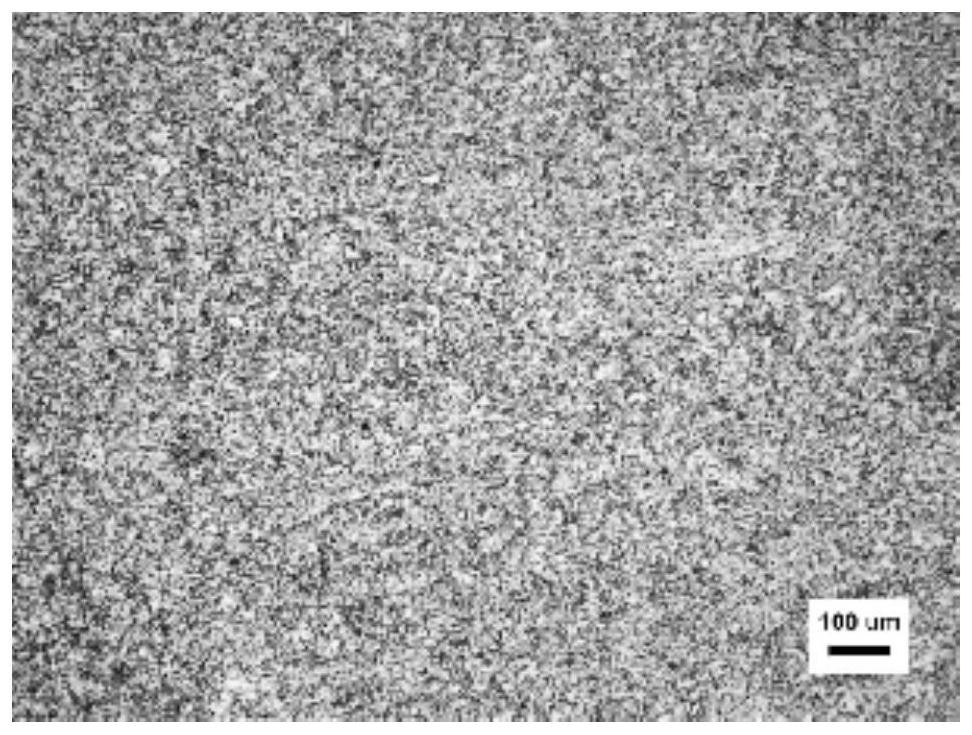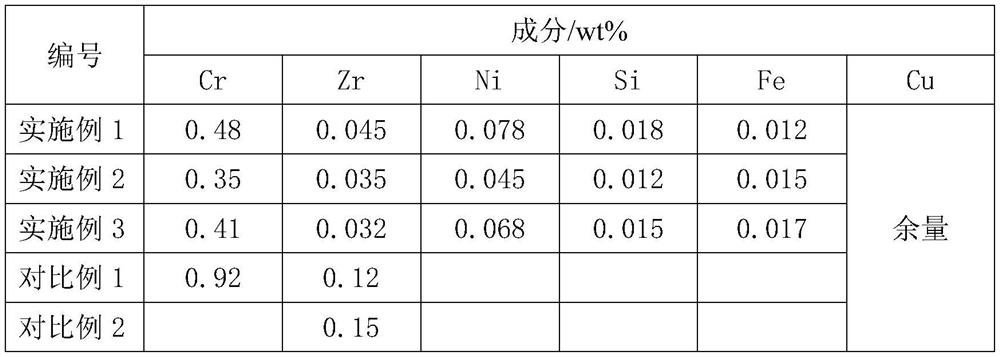Copper-chromium-zirconium alloy and preparation method thereof
A copper-chromium-zirconium and alloy technology, applied in metal/alloy conductors, cable/conductor manufacturing, conductive materials, etc., can solve the problems of short service life, high current and high resistance, and achieve long service life, high yield and high efficiency. high effect
- Summary
- Abstract
- Description
- Claims
- Application Information
AI Technical Summary
Problems solved by technology
Method used
Image
Examples
Embodiment 1
[0028] The preparation steps of this copper-chromium-zirconium alloy are as follows:
[0029] Step 1: A copper alloy wire billet is produced by a continuous casting method, and the diameter of the wire billet is 35mm.
[0030] Step 2: the first cold deformation: drawing the copper alloy wire blank obtained in step 1 with a deformation amount of 36%;
[0031] Step 3: Perform recrystallization annealing on the wire blank after cold working in step 2, the temperature is controlled at 800°C, and the holding time is 5h;
[0032] Step 4: Repeat step 2;
[0033] Step 5: Repeat step 3;
[0034] Step 6: The second cold deformation: drawing the wire billet after recrystallization annealing in step 5 with a deformation amount of 30%;
[0035] Step 7: Perform solution treatment on the wire billet after cold working in step 6, the solution temperature is controlled at 940°C, and the holding time is 1.5h;
[0036] Step 8: The third cold deformation: cold working the wire blank after sol...
Embodiment 2
[0040] The preparation steps of this copper-chromium-zirconium alloy are as follows:
[0041] Step 1: A copper alloy wire billet is produced by a continuous casting method, and the diameter of the wire billet is 30mm.
[0042] Step 2: the first cold deformation: drawing the copper alloy wire blank obtained in step 1 with a deformation amount of 30%;
[0043] Step 3: Perform recrystallization annealing on the wire blank after cold working in step 2, the temperature is controlled at 900°C, and the holding time is 1h;
[0044] Step 4: Repeat step 2;
[0045] Step 5: Repeat step 3;
[0046] Step 6: The second cold deformation: the wire billet after the recrystallization annealing in step 5 is subjected to drawing processing with a deformation amount of 36%;
[0047] Step 7: Perform solution treatment on the wire billet after cold working in step 6, the solution temperature is controlled at 980°C, and the holding time is 0.5h;
[0048] Step 8: The third cold deformation: cold wor...
Embodiment 3
[0052] The preparation steps of this copper-chromium-zirconium alloy are as follows:
[0053] Step 1: A copper alloy wire billet is produced by a continuous casting method, and the diameter of the wire billet is 25mm.
[0054] Step 2: the first cold deformation: drawing the copper alloy wire blank obtained in step 1 with a deformation amount of 30%;
[0055] Step 3: Perform recrystallization annealing on the wire blank after cold working in step 2, the temperature is controlled at 840°C, and the holding time is 4h;
[0056] Step 4: The second cold deformation: the wire billet after the recrystallization annealing in step 3 is subjected to drawing processing with a deformation amount of 32%;
[0057] Step 5: Perform solution treatment on the wire billet after cold working in step 4, control the solution temperature at 960° C., and hold for 1 hour;
[0058] Step 6: The third cold deformation: cold working the wire blank after solid solution in step 5 with a deformation amount ...
PUM
| Property | Measurement | Unit |
|---|---|---|
| hardness | aaaaa | aaaaa |
| crystal size | aaaaa | aaaaa |
| diameter | aaaaa | aaaaa |
Abstract
Description
Claims
Application Information
 Login to View More
Login to View More - R&D
- Intellectual Property
- Life Sciences
- Materials
- Tech Scout
- Unparalleled Data Quality
- Higher Quality Content
- 60% Fewer Hallucinations
Browse by: Latest US Patents, China's latest patents, Technical Efficacy Thesaurus, Application Domain, Technology Topic, Popular Technical Reports.
© 2025 PatSnap. All rights reserved.Legal|Privacy policy|Modern Slavery Act Transparency Statement|Sitemap|About US| Contact US: help@patsnap.com



